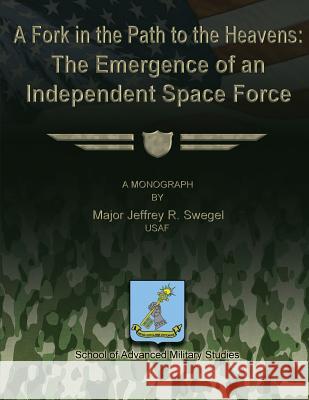A Fork in the Path to the Heavens: The Emergence of an Independent Space Force » książka
A Fork in the Path to the Heavens: The Emergence of an Independent Space Force
ISBN-13: 9781480022454 / Angielski / Miękka / 2012 / 62 str.
A Fork in the Path to the Heavens: The Emergence of an Independent Space Force
ISBN-13: 9781480022454 / Angielski / Miękka / 2012 / 62 str.
(netto: 78,58 VAT: 5%)
Najniższa cena z 30 dni: 77,15 zł
ok. 13-18 dni roboczych
Dostawa przed świętami

Darmowa dostawa!
The issues confronted by Britain and the U.S. early in the last century regarding their emerging air power capabilities were hotly debated, and the final decisions for the creation of independent Air Forces was made based on several factors, not all of which have been sufficiently explored. In the same way today, due to its huge technological advantages, the United States faces a difficult decision with regard to its space forces. The arguments for or against creation of an independent space force all have merit, but the final decision will have lasting impact on national defense. This monograph examines the current environment with regard to United States space capabilities in an attempt to determine when, if ever, the nation should create an independent service for space. To do this, it uses the U.S. Army concept of Force Development to analyze the Doctrine, Training, Leadership, Organization, Materiel and Soldier (DTLOMS) development processes. First it evaluates the concepts and programs of Britain and the United States during their attempts to come to terms with early 20th century emerging air power capabilities. This sets the framework for the reader and provides insight into the reasons why separation of the air arm was necessary if those nations were to maintain their warfighting capabilities. Once the groundwork is laid by looking at early air power, an examination of current U.S. Army, Navy and Air Force policies toward their respective services' space cadres is made using the same DTLOMS criteria to determine the effectiveness of each service's approach. Finally, by comparing the air power and space situations, and placing the latter within current U.S. national security objectives, it makes a judgment as to the effectiveness of the current space structure. The author asks if national interests would best be served by creation of an independent service now, and if not, what conditions could present themselves that would cause the national needs to best be served by the creation of a separate service. The author finds that we are at a defining moment in history with regard to U.S. aerospace dominance. The transition of space from a war-enabling medium to a war-fighting medium is upon us. With this realization, he concludes that the current national space structure is hampering development of U.S. space forces that could allow potential adversaries to close the capabilities gap. If the U.S. is to maintain its lead, it should soon move to separate space forces along the same model as that of the creation of the USAF in 1947.











